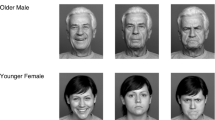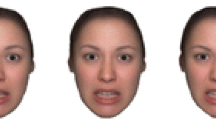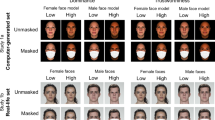Abstract
This study examined the effect of a target person’s facial asymmetry on observers’ attributions of emotion and personality, as well as appearance judgment. The first experiment investigated attributions to resting asymmetrical faces of 20 normal healthy young adults versus their symmetrical hemifacial composites. The second experiment used the same procedure with 24 expressive faces. The findings of no significant differences between the attributions to asymmetrical faces and their symmetrical hemifacial composites in both studies are explained by the very limited degree of asymmetry seen on young adults’ faces. Moreover, it is suggested that observers are not tuned to notice mild facial symmetry, and thus it does not affect attributions. As a whole, the study indicates that nonpathological facial asymmetry does not play an important role in human interaction.
Similar content being viewed by others
References
ALLEY, T. R., & HILDEBRANDT, K. A. (1988). Determinants and consequences of facial aesthetics. In T. R. Alley (Ed.), Social and applied aspects of perceiving faces (pp. 101–140). Hillsdale, NJ: Lawrence Erlbaum Associates.
BOROD, J. C. (1993). Cerebral mechanism underlying facial, prosodie, and lexical emotional expression: A review of neuropsychological studies and methodological issues. Neuropsychology, 7, 445–463.
BOROD, J., CARON, H. S., & KOFF, E. (1981). Asymmetries in positive and negative facial expressions: Sex differences. Neuropsychologia, 19, 819–824.
BRUYER, R., & CRAPS, V. (1985). Facial asymmetry: Perceptual awareness and lateral differences. Canadian Journal of Psychology, 39, 54–69.
BURKE, P. H., & HEALY, M. J. (1993). A serial study of normal facial asymmetry in monozygotic twins. Annals of Human Biology, 20, 527–534.
COREN, S., PORAC, C, & DUNCAN, P. A. (1979). A behaviorally validated self-report inventory to assess four types of lateral preferences. Journal of Clinical Neuropsychology, 1, 55–64.
EKMAN, P. (1978). Facial signs: Facts, fantasies, and possibilities. In T. Sebeok (Ed.), Sight, sound and sense (pp. 124–156). Bloomington: Indiana University Press.
EKMAN, P. (1979). About brows: Emotional and conversational signals. In M. von Cranach, K. Foppa, W. Lepenies, & D. Ploog (Eds.), Human ethology (pp. 169–202). Cambridge: Cambridge University Press.
FARKAS, L. G. (1994). Anthropometry of the attractive North American Caucasian face. In L. G. Farkas (Ed.), Anthropometry of the head and face (pp. 159–179). New York: Raven Press.
FARKAS, L. G., & CHEUNG, G. (1981). Facial asymmetry in healthy North American Caucasians. Angle Orthodontist, 51, 70–77.
FRANK, M. G., EKMAN, P., & FRIESEN, W. V. (1993). Behavioral markers and recognizability of the smile of enjoyment. Journal of Personality and Social Psychology, 644, 83–93.
GANGESTAD, S. W., THORNHILL, R., & YEO, R. A. (1994). Facial attractiveness, developmental stability, and fluctuating asymmetry. Ethology and Sociobiology, 15, 73–85.
GRAMMER, K., & THORNHILL, R. (1994). Human facial attractiveness and sexual selection: The role of averageness and symmetry. Journal of Comparative Psychology, 108, 233–242.
HEILMAN, K. M., & BOWERS, D. (1990). Neuropsychology studies of emotional changes induced by right and left hemispheric studies. In L. Stein, B. Leventhal, & T. Trabasso (Eds.), Psychological and biological approaches to emotion (pp. 97–113). Hillsdale, NJ: Erlbaum.
KARCH, G. R., & GRANT, C. W. (1978). Asymmetry in perception of the sides of the human face. Perceptual and Motor Skills, 47, 727–734.
KOWNER, R. (1995). Lateral facial asymmetry and its effect on attributions of emotion and personality: A reconsideration. Neuropsychologia, 33, 539–559.
KOWNER, R. (1996a). Facial asymmetry and attractiveness judgment in developmental perspective. Journal of Experimental Psychology: Human Perception and Performance, 22, 662–675.
KOWNER, R. (1996b). An improved technique for creating hemifacial chimeras. Behavior Research Methods, Instruments, & Computers, 28, 372–375.
KOWNER, R., & OGAWA, T. (1993). Toward a theory of the universal determinants of physical attractiveness preferences. Tsukuba Psychological Research, 15, 219–224.
KOWNER, R., & OGAWA, T. (1995). The role of raters’ sex, personality, and appearance in judgments of facial beauty. Perceptual and Motor Skills, 81, 339–349.
LANGLOIS, J. H., ROGGMAN, L. A., & MUSSELMAN, L. (1994). What is average and what is not average about attractive faces? Psychological Science, 5, 214–220.
LEARY, R. F., & ALLENDORF, F. W. (1989). Fluctuating asymmetry as an indicator of stress: Implications for conservation biology. Trends in Ecology and Evolution, 4, 214–217.
LEMAY, M. (1977). Asymmetries of the skull and handedness. Journal of the Neurological Sciences, 32, 243–253.
LIVSHITS, G., & KOBYLIANSKY, E. (1991). Fluctuating asymmetry as a possible measure of developmental homeostasis in humans. Human Biology, 63, 441–466.
MANNING, J. T, & CHAMBERLAIN, A. T (1993). Fluctuating asymmetry, sexual selection and canine teeth in primates. Proceeding of the Royal Society of London Biology, 251, 83–87.
MARKOW, T. A., & RICKER, J. P. (1992). Male size, developmental stability, and mating success in natural populations of three Drosophila species. Heredity, 69, 122–127.
MØLLER, A. P. (1992). Female swallow preference for symmetrical male sexual ornaments. Nature, 357, 238–240.
OSGOOD, C. E. (1966). Dimensionality of the semantic space for communication via facial expression. Scandinavian Journal of Psychology, 7, 1–30.
PALMER, R. A., & STROBECK, C. (1986). Fluctuating asymmetry: Measurement, analysis, patterns. Annual Review of Ecology and Systemtics, 17, 391–421.
PARSONS, P. A. (1990). Fluctuating asymmetry: An epigenetic measure of stress. Biological Review, 65, 131–145.
PECK, H., PECK, S., & KATAJA, M. (1991). Skeletal asymmetry in esthetically pleasing faces. Angle Orthodontist, 61, 43–48.
RINN, W. E. (1984). The neuropsychology of facial expression: A review of the neurological and psychological mechanisms for producing facial expressions. Psychological Bulletin, 95, 52–77.
SACKEIM, H. A. (1985). Morphologic asymmetries of the face: A review. Brain and Cognition, 4, 296–312.
SHAW, W. C. (1988). Social aspects of dentofacial anomalies. In T. R. Alley (Ed.), Social and applied aspects of perceiving faces (pp. 191–216). Hillsdale, NJ: Lawrence Erlbaum Associates.
SILBERMAN, E. K., & WEINGARTEN, H. (1986). Hemispheric lateralization of functions related to emotion. Brain and Cognition, 5, 322–353.
SKINNER, M., & MULLEN, B. (1991). Facial asymmetry in emotional expression: A meta-analysis of research. British Journal of Social Psychology, 30, 113–124.
SUTTON, P. R. N. (1969). Bizygomatic diameter: The thickness of the soft tissues over the zygions. American Journal of Physical Anthropology, 30, 303–310.
SWADDLE, J. P., & CUTHILL, I. C. (1995). Asymmetry and human facial attractiveness: Symmetry may not be always beautiful. Proceedings of the Royal Society of London, 261, 111–116.
THORNHILL, R. (1992). Fluctuating asymmetry and the mating system of the Japanese Scorpionfly Panorpa japonica. Animal Behaviour, 44, 867–879.
WALKER-SMITH, J. G., GALE, A. G., & FINDLY, J. M. (1977). Eye movement strategies in face perception. Perception, 6, 313–326.
WOO, T. L. (1931). On the asymmetry of the human skull. Biometrica, 22, 324–341.
Author information
Authors and Affiliations
Additional information
This research is based in part on a PhD thesis by Rotem Kowner and was supported by the Japanese Ministry of Education, Culture, and Science. Preliminary findings of this research were presented at the annual meeting of the Japanese Psychological Association, Tokorozawa, August 1993. I thank Toshiki Ogawa, Randy Thornhill, and several anonymous referees for their comments on earlier drafts, as well as Haruhiko Shobo, Shigeru Yoshida, Takashi Sugihara, and Eikyun Kim for their contribution to the empirical part of this research.
Rights and permissions
About this article
Cite this article
Kowner, R. The perception and attribution of facial asymmetry in normal adults. Psychol Rec 47, 371–384 (1997). https://doi.org/10.1007/BF03395232
Published:
Issue Date:
DOI: https://doi.org/10.1007/BF03395232




